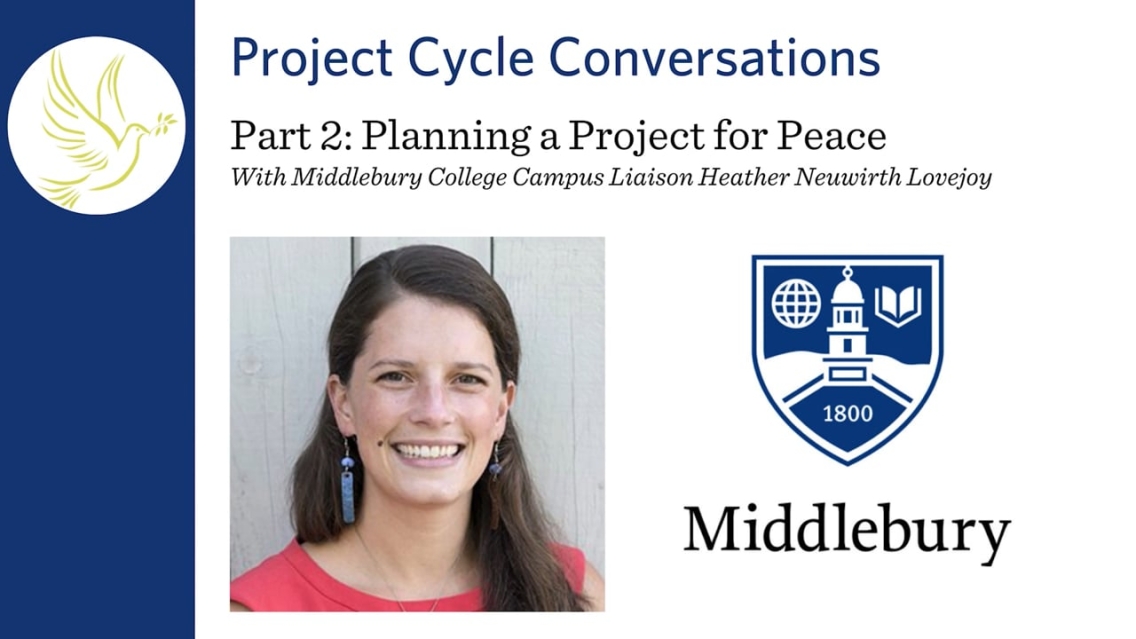Stage 2: Planning
Stage Two: Planning
During this stage, you will refine your project concept. That means assessing your resources—time, money, skills, knowledge, and networks— and creating a feasible plan.
By the end of this stage, you’ll be ready to submit two documents for submission: the proposal narrative and the project budget. These documents are essential in terms of securing Projects for Peace funding but are only two components of your roadmap for implementation.
In this second project cycle video, Heather shares best practices for creating your proposal and budget, as well as a variety of tips for how to successfully transform ideas into plans.
Questions About Planning
How do I refine my project goals?
Try asking yourself:
- What is at the heart of this project? What will I/we do and why?
- How am I including others in defining goals?
- During the project, how will I/we know if I am making progress?
- What are the major milestones?
- What aspects of your project goals can be easily quantified? What aspects can’t?
- At the end of the project, will something be different? How will I/we know?
How can I start building relationships with community partners?
Each Project for Peace community looks different. You may be working in a community that is new to you, or someplace where you have strong ties. You may be doing a project alone or with a project team. In all instances, establishing and nurturing partnerships is integral to successful projects.
You might begin by listing who exactly you intend to work with, and why. Assume this list will evolve throughout your project.
Getting ready to partner involves self-reflection and perspective-taking. Try asking yourself:
- How do I want to “show up” for these and other colleagues?
- How do I typically engage when a conflict occurs?
- How will my values be present—and transparent—in the ways I engage with partners?
- What may impede or facilitate someone’s interest and/or availability in working with me?
- What expectations do we have of one another before, during, and after the project? How can we manage expectations as we implement?
- Who will be involved in decision-making? Why?
- How will we manage any language or communication barriers?
- What conflicts already exist among partners or might arise in the course of the project?
- What can I do to prevent or manage conflicts about goals, schedules, budgets, or anything else?
How should I develop my project schedule?
Begin by drafting a timeline. List out the start and end dates for your project as well as any major milestones (achievements) along the way so you can sort them chronologically and get a sense of the pacing.
Next, brainstorm and sequence the large and small tasks that are necessary for implementing your project. Add dates and integrate the tasks into your timeline. Notice any dependencies (when one task depends on another task being completed) and think through where you do or don’t have flexibility.
Ensure you are supporting equitable participation by considering the schedules of those you will work with—are there times of the day/month/year when they are more or less available? Ask about holidays, childcare responsibilities, work activities, transportation availability, weather patterns, academic calendars, etc., and then adjust your timeline accordingly.
Don’t forget to schedule check-ins with your campus liaison, mentors, or other thought partners throughout the project, and remain aware of interim and final report deadlines.
How should I develop my budget?
You can begin by reviewing the Projects for Peace budget template and guidance, and brainstorming all of the expenses you expect to have for each category. Review your timeline and highlight the tasks and activities that have associated costs.
Ask your campus liaison about how the transfer of funds works on your campus so that you understand the process and timing.
Don’t forget to include taxes, exchange rates, bank fees, seasonal shifts in cost, transportation costs, funding for social events, and/or a closing celebration. Your campus liaison may have other tips.
Try asking yourself:
- Am I confident that I have realistic (and local) estimates of costs? If not, how can I improve my estimates?
- Might costs vary according to season or location of purchase? What trade-offs might I need to make for convenience and cost savings?
- What will I do if my costs exceed my budget? What can I do if I have funds left over?
How do I include safety and well-being in my planning?
Take the time to plan for accommodations, transportation, communication channels, sources of food, access to healthcare, medicines, tax liabilities, and sources of support in case of an emergency.
You can also run through different scenarios with thought partners: What could go wrong? How can we prepare? What contingencies can we put in place?
Be sure to check in with your campus liaison on campus-specific deadlines and requirements related to safety and health, so that you are working in accordance with risk-management policies.
How do I complete my Projects for Peace application?
The steps for completing an application should include the following:
- Download the proposal and budget guidance from this website, and review them carefully.
- Confirm the application process with your campus liaison. What are the internal (university/college) deadlines? Will you receive feedback? Will there be an interview?
- Draft and redraft your proposal and budget, and seek feedback from mentors and partners.
Keep in mind that the proposal narrative is just two pages, so it can’t function as a comprehensive project plan. You’ll want to organize and retain all your notes.
Additional Resources
Relevant resources for the planning stage will be added here as they become available. If you need further guidance, reach out to your campus liaison for support.


